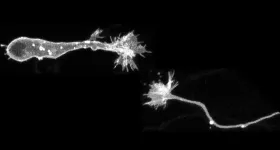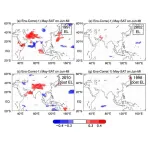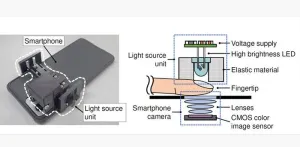(Press-News.org) The structure and functions of the tip of migrating neurons remain elusive. Here, a research group led by Kazunobu Sawamoto, Professor at Nagoya City University and National Institute for Physiological Sciences, and by Chikako Nakajima and Masato Sawada, staff scientists in his laboratory, has found that the PTPσ-expressing growth cone senses the extracellular matrix and drives neuronal migration in the injured brain, leading to functional recovery.
Neural stem cells are present in the postnatal mammalian brain and produce new neurons. New neurons migrate toward injured sites, and promoting neuronal migration results in functional recovery after brain injury. Nevertheless, there is an inhibitory effect on neuronal migration in the injured sites, the mechanisms of which need to be elucidated in order to improve recruitment of new neurons in the injured sites and thus to enhance the recovery after brain injury. The migrating neurons possess an axonal growth cone-like structure at their tip, but the role of this structure in neuronal migration has not been fully understood.
Sawamoto’s group focused on elucidating the function of the growth cone-like structure of migrating neurons of the mouse brain. The researchers used super-resolution microscopy to study the cytoskeletal dynamics and molecular features of the neuronal tip. They showed that the tip structure shares important functions with axonal growth cones. In short, the growth cone of cultured migrating neurons is responsive to external signals through tyrosine phosphatase receptor type sigma (PTPσ) to guide the directionality of migration and initiate the movement of their cell body. The growth cone responds to chondroitin sulfate (CS) through PTPσ and collapses, resulting in inhibition of neuronal migration. In the presence of CS, the growth cones can revert to their extended morphology when they interact with heparan sulfate (HS), thus re-enabling neuronal migration.
“To investigate whether the effect of HS in reversing the inhibitory effect of CS can promote neuronal migration in the injured brain, it was necessary to apply HS-containing biomaterial to the CS-rich injured brain,” Sawamoto said.
Next, they employed HS-containing gelatin-fiber nonwoven fabric, a biomaterial that provides structural scaffolds for cells such as migrating neurons. They showed that the applied HS-containing fibers promoted extension of growth cones and neuronal migration in the injured brain. Furthermore, implantation of the HS-enriched gelatin fabric promoted the regeneration of mature neurons and restored neurological functions. These results suggest that elucidating the molecular mechanisms of growth cone-mediated interaction with the local extracellular environment may enable the development of new regeneration technologies based on the promotion of neuronal migration.
Recent studies by other groups have shown that aging alters the physical properties of brain extracellular matrix, including CSPG.
“Given that the growth cone of migrating neurons serves as a primer for neuronal migration under inhibitory extracellular conditions, it is necessary to further investigate whether the growth cone-mediated treatment to recruit new neurons from the endogenous source to the damaged sites is also applicable to aged brains,” Nakajima commented.
The full findings of the study are published in Nature Communications.
Article title: Identification of the growth cone as a probe and driver of neuronal migration in the injured brain. DOI: 10.1038/s41467-024-45825-8
In addition to Kazunobu Sawamoto, Chikako Nakajima, and Masato Sawada, co-authors of this research article include researchers from Nagoya City University, National Institute for Physiological Sciences, Niigata University, Kyoto University, Doshisha University, Jichi Medical University, The Japan Wool Textile Co., Ltd., Nikke Medical Co., Ltd., Toray Research Center, Inc., New York University, Friedrich Schiller University Jena, University of Valencia, and University of Pennsylvania.
END
Deciphering the tip of migrating neurons: Discovery of growth cone in migrating neurons involved in promoting neuronal migration and regeneration in the brain after injury
Migrating neurons possess a growth cone that shares functions with axonal growth cones and regulates neuronal migration by interaction with the extracellular environment
2024-03-09
ELSE PRESS RELEASES FROM THIS DATE:
Land or sea? Scientists reveal effect of land conditions on Asian monsoon climate
2024-03-09
Tokyo, Japan – Researchers from Tokyo Metropolitan University have used numerical simulations to show how conditions on land impact weather during Asian summer monsoons. Focusing on the Tibetan plateau, they studied how varied land conditions combined with fixed maritime conditions illuminate the specific effects of the land on the weather. They found that the significance of land-atmosphere coupling varies greatly from year to year, with unexpectedly low dependence on maritime phenomena like El Niño.
Asian monsoon systems impact some of the most highly populated areas of the world, affecting enormous swathes of Asia and ...
What heat can tell us about battery chemistry: using the Peltier effect to study lithium-ion cells
2024-03-08
Batteries are usually studied via electrical properties like voltage and current, but new research suggests that observing how heat flows in conjunction with electricity can give important insights into battery chemistry.
A team of researchers at the University of Illinois Urbana-Champaign has demonstrated how to study chemical properties of lithium-ion battery cells by exploiting the Peltier effect, in which electrical current causes a system to draw heat. Reported in the journal Physical Chemistry Chemical Physics, this ...
NRL participates in international campaign investigating polar low phenomena
2024-03-08
WASHINGTON – U.S. Naval Research Laboratory (NRL) research meteorologist James Doyle, Ph.D., joins an international team of scientists to investigate meteorological processes associated with Arctic cold air outbreaks.
From late February through early April, the 45-day international field campaign CAESAR, short for Cold-Air outbreak Experiment in the Sub-Arctic Region, is focused on cold-air outbreaks that occur as cold Arctic air flows-out over warmer open waters between northern Norway and ...
Are mountains carbon dioxide sources or sinks? New study finds they can be both
2024-03-08
There’s been a long-running debate in Earth sciences over whether mountains are a source of carbon dioxide or if they remove carbon dioxide from the atmosphere through mineral weathering. A new study has found that mountains can be sources or sinks and has identified the tipping point at which they switch from one to the other.
The study — by Ludwig Maximilian University of Munich, Colorado State University and the German Research Centre for Geosciences — found that many mountains exist on a spectrum of removing or releasing carbon, and erosion rates determine the impact of mountains ...
Child care costs, availability keeping New York parents at home, poll finds
2024-03-08
BUFFALO, N.Y. - Two out of five New Yorkers with children who participated in a recent poll report that a member of their household opts not to work, mostly because child care is too expensive, while child care workers earn among the lowest wages in the state, according to a report released March 8 by the Cornell School of Industrial and Labor Relations Buffalo Co-Lab.
Continuing a multiyear effort with collaborators to determine the “true” cost of child care, “The Status of Child Care in New York State” finds that recent increases in state subsidies helped stabilize ...
Blood pressure control in veterans declined during the COVID-19 pandemic
2024-03-08
A multi-institution team led by researchers at the White River Junction VA Medical Center in Vermont found that Veterans’ blood pressure control worsened due to disrupted care during the COVID-19 pandemic. The findings were published in the journal Medical Care.
The researchers followed a group of nearly 1.65 million Veterans who received their care at VA and who had high blood pressure (hypertension) during two periods—before the pandemic and during the pandemic. In Veterans with controlled blood pressure, researchers found a 7% decline in control during the pandemic compared ...
Lighting the way to noninvasive blood glucose monitoring using portable devices
2024-03-08
Diabetes is a very prevalent disease that, unfortunately, still has no treatment. People with diabetes need to monitor their blood glucose levels (BGLs) regularly and administer insulin to keep them in check. In almost all cases, BGL measurements involve drawing blood from a fingertip through a finger prick. Since this procedure is painful, less invasive alternatives that leverage modern electronics are being actively researched worldwide.
Thus far, several methods to measure BGL have been proposed; using infrared light is a prominent example, and mid-infrared light-based devices have shown reasonable performance. However, the required sources, ...
What's behind the surge of fatty liver disease in Latinx kids?
2024-03-08
For Latinx kids, unreliable access to food at age 4 raises the odds of having fatty liver disease later in childhood by nearly four times, a new UC San Francisco-led study found.
About 5% to 10% of children in the United States have nonalcoholic fatty liver disease, putting its prevalence on par with asthma. Pediatric cases have spiked in the last decade, with millions now affected by a disease marked by pain, fatigue and jaundice that can lead to cirrhosis, cancer and organ transplantation. Latinx children and adults ...
nTIDE February 2024 Jobs Report: Overall employment trend still positive despite recent declines for people with disabilities
2024-03-08
East Hanover, NJ – March 8, 2024 – Despite recent declines in the labor force participation rate and employment-to-population ratio, the overall employment trend remains positive for people with disabilities, according to today’s National Trends in Disability Employment – semi-monthly update (nTIDE), issued by Kessler Foundation and the University of New Hampshire’s Institute on Disability (UNH-IOD).
Month-to-Month nTIDE Numbers (comparing January 2024 to February 2024)
Based on data from the U.S. Bureau of Labor Statistics ...
Locating single neurons that monitor and regulate the heart and lungs
2024-03-08
The body self-regulates in a process known as homeostasis, and the brain is responsible for this
as it is constantly monitoring all of the body’s vital signals. If you need more oxygen, for
example, then a message is sent to the brain that then tells the body to adjust your breathing
and your heart rate. But the neurons involved in regulating breathing and cardiac rhythm had
never been directly observed, until now, thanks to brain recording technology during brain
surgery.
EPFL neuroscientists, in a collaboration with surgeons and neuroscientists at West Virginia
University Rockefeller Neuroscience ...
LAST 30 PRESS RELEASES:
Decoupling the HOR enhancement on PtRu: Dynamically matching interfacial water to reaction coordinates
Sulfur isn’t poisonous when it synergistically acts with phosphine in olefins hydroformylation
URI researchers uncover molecular mechanisms behind speciation in corals
Chitin based carbon aerogel offers a cleaner way to store thermal energy
Tracing hidden sources of nitrate pollution in rapidly changing rural urban landscapes
Viruses on plastic pollution may quietly accelerate the spread of antibiotic resistance
Three UH Rainbow Babies & Children’s faculty elected to prestigious American Pediatric Society
Tunnel resilience models unveiled to aid post-earthquake recovery
Satellite communication systems: the future of 5G/6G connectivity
Space computing power networks: a new frontier for satellite technologies
Experiments advance potential of protein that makes hydrogen sulfide as a therapeutic target for Alzheimer’s disease
Examining private equity’s role in fertility care
Current Molecular Pharmacology achieves a landmark: real-time CiteScore advances to 7.2
Skeletal muscle epigenetic clocks developed using postmortem tissue from an Asian population
Estimating unemployment rates with social media data
Climate policies can backfire by eroding “green” values, study finds
Too much screen time too soon? A*STAR study links infant screen exposure to brain changes and teen anxiety
Global psychiatry mourns Professor Dan Stein, visionary who transformed mental health science across Africa and beyond
KIST develops eco-friendly palladium recovery technology to safeguard resource security
Statins significantly reduce mortality risk for adults with diabetes, regardless of cardiovascular risk
Brain immune cells may drive more damage in females than males with Alzheimer’s
Evidence-based recommendations empower clinicians to manage epilepsy in pregnancy
Fungus turns bark beetles’ defenses against them
There are new antivirals being tested for herpesviruses. Scientists now know how they work
CDI scientist, colleagues author review of global burden of fungus Candida auris
How does stroke influence speech comprehension?
B cells transiently unlock their plasticity, risking lymphoma development
Advanced AI dodel predicts spoken language outcomes in deaf children after cochlear implants
Multimodal imaging-based cerebral blood flow prediction model development in simulated microgravity
Accelerated streaming subgraph matching framework is faster, more robust, and scalable
[Press-News.org] Deciphering the tip of migrating neurons: Discovery of growth cone in migrating neurons involved in promoting neuronal migration and regeneration in the brain after injuryMigrating neurons possess a growth cone that shares functions with axonal growth cones and regulates neuronal migration by interaction with the extracellular environment





